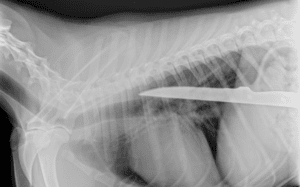As so many of us know, having a young dog or cat as part of your family is much like living with a toddler… toilet training, locking away hazards, and growing eyes in the back of your head. The common dangers are identified and avoided— lilies no longer put in vases where cats can reach, grapes and chocolate kept out of sight and smell, and antifreeze put on a high up shelf. However, there are always the unexpected hazards, the hazard that you would never have dreamed. And…. leave it up to a young lab to test the limits.
It was a Saturday around dinnertime when we received a call from a panicked owner. She stated that her 18-month-old Labrador mix had just swallowed a steak knife. Now this young pup, we’ll call her Fiona, had a history of testing the limits of obedience but this was a new limit. Fiona had grabbed the knife off of the kitchen counter as her mom was preparing dinner. Her mom immediately saw what had happened and commanded Fiona to “drop it”. So, like most ‘teenage’ pups, she did the complete opposite and swallowed it. We encouraged her to keep Fiona as quiet and still as possible (a near impossible request to make of an 18 month old lab mix) and to come straight to the Ann Arbor Animal Hospital.
As soon as Fiona arrived, the ICU swung into action. Fiona was triaged and taken immediately to x-ray to determine the location of the knife and her immediate dangers. The radiograph showed that the knife had been swallowed blunt end first, very fortunate for Fiona. The knife was lodged in her esophagus unable to pass into the stomach due to its size. There was significant concern for laceration to the esophagus and damage to other thoracic structures including her trachea, heart, lungs, and major arteries/veins. 
Once I had evaluated the radiograph (and sedated Fiona to stop her from excessive movement that might cause further damage) I began evaluating strategies for safe removal of the knife. Inducing vomiting and endoscopic retrieval were dangerous options since the knife had been swallowed point up, there was too much risk of tracheal and laryngeal trauma on its way out. Surgical removal through the stomach was going to be the safest option.
Fiona was then anesthetized and prepared for surgery by our team of Veterinary Technicians, being monitored with blood pressure, ECG, and pulse oximetry much as you or I would be when we are anesthetized. In surgery I was able to safely remove the knife through an incision in her stomach. As soon as the knife was removed from her esophagus, one of our critical care veterinarians was evaluating her esophagus with the endoscope to ensure that it had not been cut or damaged by the knife. Fortunately enough, there was no damage to the esophagus. Fiona was discovered to be one lucky pup with none of the injuries she was at risk for!
Fiona spent another 24 hours in the hospital recovering from the surgery and the knife swallowing without complication and was discharged to her much relieved mom and dad the next evening. On most recent follow up she was back to her normal self, and all the knives in the house are under lock and key!
Pets can get into a number of different strange, interesting and in some cases dangerous things. So much so that a national veterinary publication has a contest each year where veterinarians send in radiographs of patients they’ve treated. To see what some other pets have eaten and shouldn’t have, check out this article and pictures at Pet XRay 2013 Winners.
Submitted by Dr. Morgan Peterman, Emergency/Critical Care Service
Recent Posts
About Us
Ann Arbor Animal Hospital is a locally-owned animal hospital operating for over 90 years in Ann Arbor, MI.
